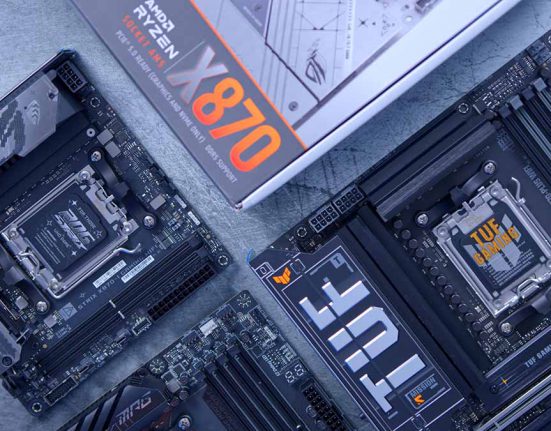Introduction
X670E motherboards are part of AMD’s Ryzen 7000 range of CPUs, sporting top-end features geared towards those with a bit more money to spend on their PC build. The best X670E motherboards fully encapsulate the strengths of the AM5 platform by offering features such as USB 4, widespread PCI-E 5.0, high speed overclocking, and more. Although these motherboards are generally pricier than their B650 and B650E counterparts, they’re worth considering if you’re building a top-end or mid-range system.
With a plethora of X670E motherboards on the market from a vast range of varying brands, how do you choose? In our latest testing roundup, we’ve gathered up an excellent selection of X670E motherboards, evaluating each one, to see which are worth considering, and which X670E board is the best on the market. We’ve analysed each X670E motherboard in full, and we’ll be breaking down why we’ve selected each one, and what they offer for your Ryzen 7000 PC build.
Suggested Article: Best RTX 4070 Ti Prebuilts
The Best X670E Motherboards to Buy
1. MSI MEG X670E ACE
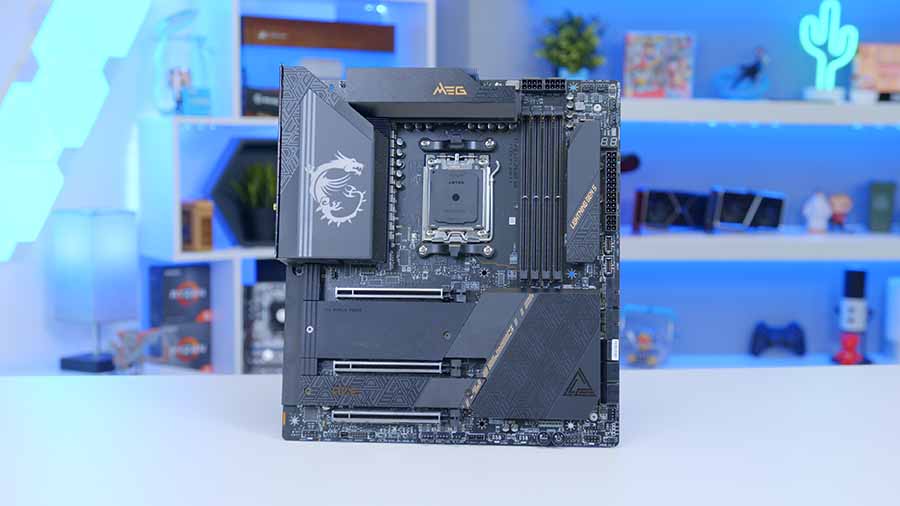
MSI’s MEG X670E ACE is the best overall option in this roundup, sporting the most features out of pretty much any motherboard that exists on the AM5 platform. The MEG X670E ACE is a sleek and gorgeous looking board, geared towards enthusiasts that are looking to make the most out of their Ryzen 7000 PC build. This X670E motherboard has pretty much anything you could want, including support for 8000MT/s RAM, along with a 22+2+1 power phase design, which is perfect for overclocking top-end CPUs. Expansion wise, this board puts a massive focus on widespread PCI-E 5.0, offering consumers three Gen5 x16 slots, alongside a Gen5 SSD slot too.
| MSI MEG X670E ACE | Specification |
|---|---|
| Form Factor | E-ATX |
| Supported Memory | 192GB DDR5 8000MT/s |
| PCI-E x16 Slots | 3x PCI-E 5.0 |
| PCI-E x4 Slots | 1x PCI-E 5.0 3x PCI-E 4.0 |
| Rear IO | 2x USB 3.2 Gen2x2 Type-C 1x USB 3.2 Gen2 Type-C 8x USB 3.2 Gen2 |
| Networking | 10 Gigabit LAN WiFi 6E |
Networking and connectivity is extremely impressive, with consumers being able to leverage 10 Gigabit LAN, and WiFi 6E which is perfect for massive file transfers. And on the rear IO, there’s not a single USB 2.0 port in sight, with the vast make up of the ports being USB 3.2 Gen2, rated up to 10Gbps. Needless to say, this motherboard is one of the best options on the market, encapsulating the new technologies that the AM5 platform can make use of. But its biggest weakness is the price. While the X670E ACE is an awesome board it doesn’t come in at a price that many consumers will be happy spending on a motherboard alone.

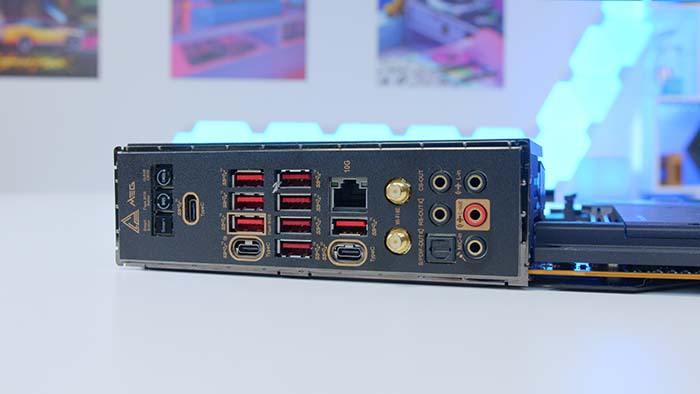
2. ASUS TUF Gaming X670E-Plus WiFi

The ASUS TUF Gaming X670E-Plus WiFi is a cheaper X670E motherboard that offers features geared towards the mid-range side of the market. Consumers can expect solid performance across the board, along with a well-rounded industrial gamer themed aesthetic that will blend in well with other components. Looking at features, the TUF Gaming X670E-Plus WiFi offers 14+2 VRM power phases, which should be enough for a reasonable overclock, along with four DDR5 DIMM slots that can be clocked up to 8000MT/s. Consumers can also leverage PCI-E 5.0 on for both GPUs and SSDs.
| ASUS TUF Gaming X670E-Plus WiFi | Specification |
|---|---|
| Form Factor | ATX |
| Supported Memory | 192GB DDR5 8000MT/s |
| PCI-E x16 Slots | 1x PCI-E 5.0 1x PCI-E 4.0 |
| PCI-E x4 Slots | 1x PCI-E 5.0 4x PCI-E 4.0 |
| Rear IO | 1x USB 3.2 Gen2x2 Type-C 1x USB 3.2 Gen2 Type-C 3x USB 3.2 Gen2 5x USB 3.2 Gen1 |
| Networking | 2.5 Gigabit LAN WiFi 6E |
Connectivity and networking is also pretty solid here too, with no USB 2.0 in sight, and only high speed USB 3.2 Gen2 ports, along with support for WiFi 6E. Overall, the TUF Gaming X670E-Plus WiFi is a decent option, coming in at a lower price point than most X670E boards on the market. Its main weakness stems from the lack of VRM power phases. Consumers looking to push their system with a high overclock will want to consider another board with better CPU power delivery.

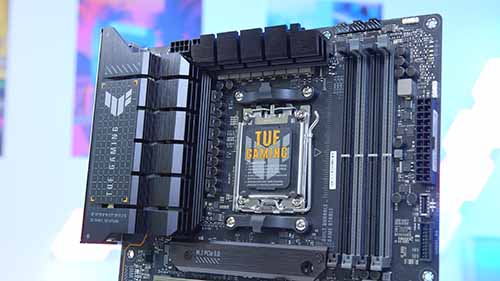
3. Gigabyte X670E AORUS Master

Gigabyte’s X670E AORUS Master is a top-end motherboard, offering a stronger set of features in comparison to the above TUF Gaming X670E-Plus. Sporting a 16+2+2 VRM power phase design, and support for up to 8000MT/s on the RAM speed, making this X670E board a ‘master’ when it comes to overclocking. What’s more, the impressive brushed steel design on the heatsinks adds some nice contrast to the overall theme of this board. Looking at expansion, consumers can leverage two Gen5 M.2 slots, and a Gen5 graphics card slot, ready for the next generation of GPUs.
| Gigabyte X670E AORUS Master | Specification |
|---|---|
| Form Factor | E-ATX |
| Supported Memory | 192GB DDR5 8000MT/s |
| PCI-E x16 Slots | 1x PCI-E 5.0 1x PCI-E 4.0 |
| PCI-E x4 Slots | 2x PCI-E 5.0 2x PCI-E 4.0 |
| Rear IO | 1x USB 3.2 Gen2x2 Type-C 2x USB 3.2 Gen2 4x USB 3.2 Gen1 |
| Networking | 2.5 Gigabit LAN WiFi 6E |
As expected, this high-end option offers a vast set of high speed ports, which includes a USB 3.2 Gen2x2 option, offering up to 20Gbps speeds. Networking is also excellent, with support for 2.5 Gigabit LAN, and WiFi 6E as well. We’re a big fan of the AORUS Master, and this X670E motherboard has featured many a time in a piece of top-end build content, however, there’s nothing in particular that makes this option stand out above other high-end X670E boards we’ve seen. The AORUS Master almost sits in an awkward spot when you compare it to the likes of ASUS or MSI options on the market.


4. ASUS ROG STRIX X670E-I Gaming WiFi
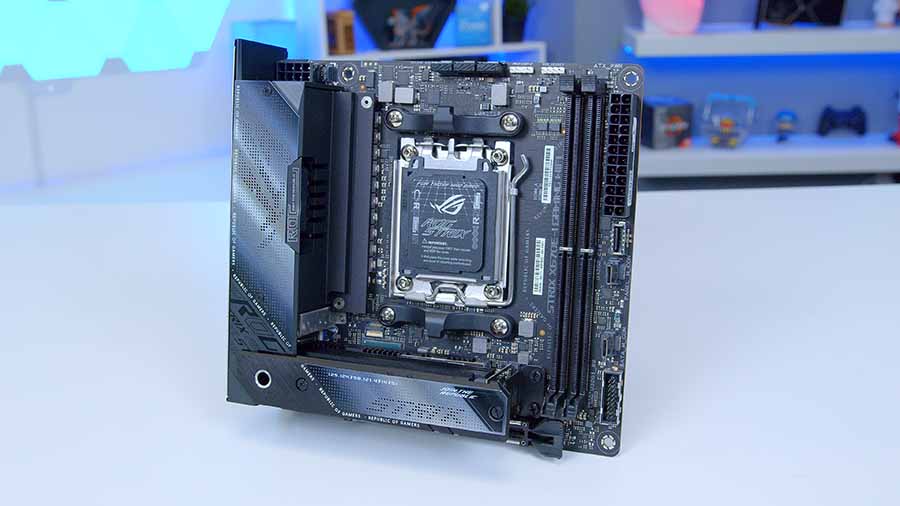
The ROG STRIX X670E-I Gaming WiFi from ASUS slims things down slightly in terms of size, as this is an ITX motherboard but it is still considered as one of the best X670E motherboards available. Despite being smaller, this particular X670E option massively focuses on features to ensure that consumers are still getting the best out of their board, regardless of the size. Moving onto features, the ROG STRIX X670E-I offers two DIMM slots, which can clock up to 8000MT/s. VRM power phases aren’t spectacular, with the X670E-I offering 10+2 power stages, but this is to be expected due to the size of the board. Consumers can also leverage a Gen5 graphics card and SSD slot. It’s worth noting that there’s only one GPU slot for this particular board due to its size.
| ASUS ROG STRIX X670E-I Gaming WiFi | Specification |
|---|---|
| Form Factor | Mini-ITX |
| Supported Memory | 96GB DDR5 8000MT/s |
| PCI-E x16 Slots | 1x PCI-E 5.0 |
| PCI-E x4 Slots | 1x PCI-E 5.0 1x PCI-E 4.0 2 x SATA 6Gb/s ports* |
| Rear IO | 2x USB4® Type-C 5x USB 3.2 Gen2 3x USB 2.0 |
| Networking | 2.5 Gigabit LAN WiFi 6E |
Connectivity however, is excellent with this being the first board in this roundup to offer dual USB, along with a whole host of other high speed options. USB ports can also be further expanded with the included ROG STRIX Hive, and ROG FPS-II add-in card. The ROG STRIX X670E-I really maximises features, despite having the obvious constraint of size, but ASUS have really pushed the boat out when it comes to features. But it is worth noting that this is probably one of the most expensive X670E motherboards on the market, especially for an ITX option.
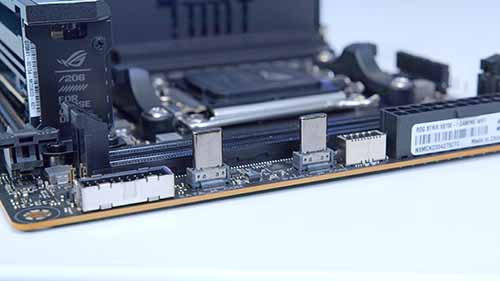

How We Tested the Best X670E Motherboards
To determine which X670E motherboard is the best option on the market, all of the boards that we’ve looked at have gone through the wringer in a series of tests and analysis. We do this to ensure each board performs as expected, but also to forge a solid overview on the kind of features available so we can compare each X670E motherboard against the rest of the market. There are also a plethora of considerations that we take into account when analysing motherboards:
- Form Factor
- PCI-E Expansion Options
- USB Ports
- Networking
- Usability and Quality of Life Features
- Design
- Pricing
Frequently Asked Questions
Are X670E Motherboards Worth It?
X670E motherboards offer the best set of features out of any other AMD chipsets on the market, so they will be worth it for many consumers. But pricing is the biggest caveat that you will have to face in comparison to cheaper chipset options.
Do X670E Motherboards Support DDR4 RAM?
No they don’t. All AMD Ryzen 7000 motherboards are DDR5 only.
Is PCI-E 5.0 Important?
Not yet, but it will be. Only SSDs can currently use PCI-E 5.0 bandwidth, but graphics cards are likely to utilise this later down the line in order to increase performance metrics, so having a PCI-E 5.0 slot will be useful if you’re likely to upgrade.











